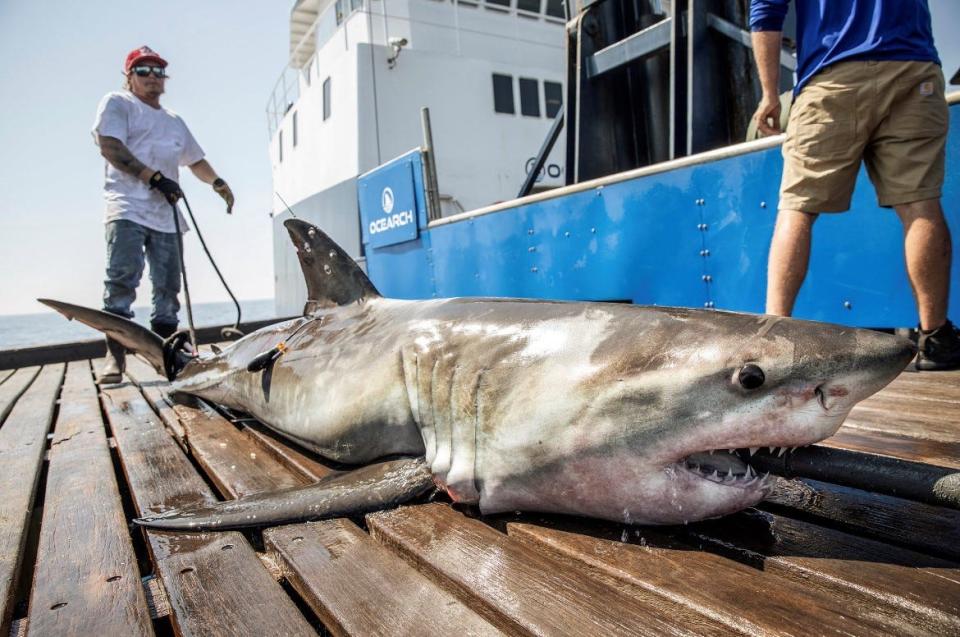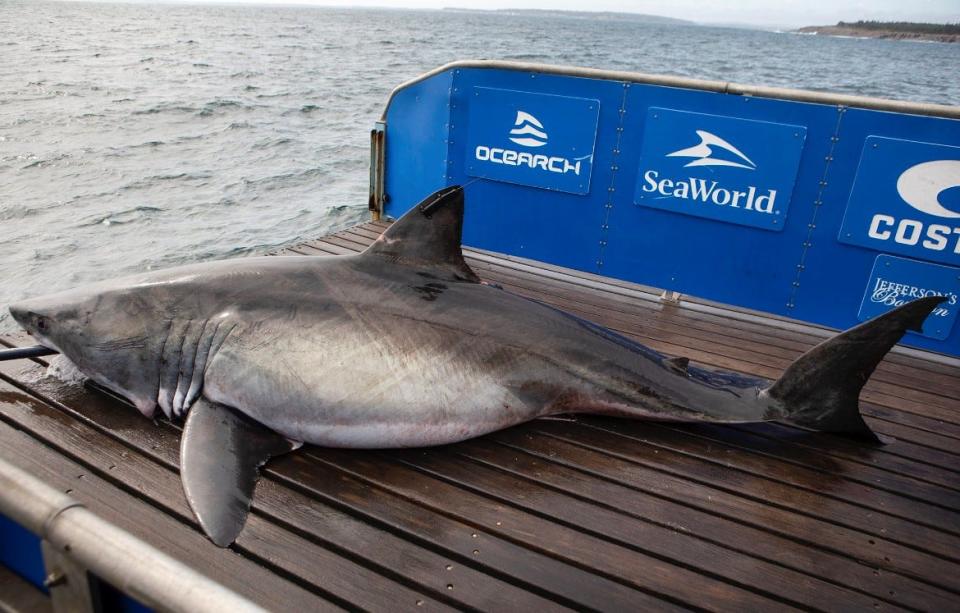More great white sharks spotted cruising off NJ coast as migration drive kicks in
Two great white sharks "pinged" offshore of the New Jersey coastline this week, while a third shark was not too far behind and was off Long Island, as the apex predators' migration is in full swing.
The three are tagged great whites that are being tracked by OCEARCH, a nonprofit research group that has been studying the sharks' behavior for over a decade off the eastern seaboard of the U.S. and Canada. To date, the group has tagged 92 great whites, eight short of its goal of 100 sharks.
The largest of those sharks is Nukumi, a 17-foot 3,541-pound female great white that last pinged on April 11, 2021 just east of the Mid-Atlantic Ridge. She was captured and tagged on Oct. 2, 2020, off the shores of Nova Scotia. She's named after a Native American Mi'kmaq legend.
See Nukumi get tagged in the video at the top of the story.
OCEARCH data shows a trend in which larger animals demonstrate greater use of the waters off the continental shelf when compared with juvenile animals, particularly adult female animals.

The latest ping on the Jersey Shore — although it occurred closer to the submarine canyons that start about 85 miles off the coast here — was Ocracoke, a juvenile male white shark. The shark "pinged" at 10:20 a.m. Thursday. A ping occurs when the shark's dorsal fin is above water long enough for the GPS tag it is carrying to be picked up by satellite.
More sharks: Great white shark Jekyll on the move off Jersey Shore, migrates by LBI
Ocracoke measured 9 feet, 7 inches and 430 pounds when he was tagged this past April off Ocracoke Island, North Carolina. OCEARCH often nicknames sharks after the location where they're tagged. Ocracoke swam at least as far north as Little Dover lsland, Nova Scotia, this summer, according to OCEARCH's global shark tracker. That was the farthest point the shark "pinged."
The other shark off New Jersey is Mahone, a bigger adult male great white that was over 13 feet long and 1,701 pounds when it was tagged. Mahone was near the Hudson Canyon, a prolific foraging ground for tuna, sharks and whales, at about 9 p.m. Wednesday. Mahone was tagged off Nova Scotia one day before Nukumi was captured.

Ocracoke and Mahone appear to be headed to the waters off the southeastern coast. Mahone has swam as far south as Daytona Beach, Florida, in previous migrations. The extensive range of habitat that white sharks use for winter residency from December to mid-May extends from Cape Hatteras, North Carolina, to the Atlantic Coast of Florida and into the Gulf of Mexico, OCEARCH has found.
The third shark that pinged off Long Island last week is Caroline, a 12-foot, 1,438-pound female that traveled across the Gulf of Mexico to waters off the coast of Veracruz, Mexico, last winter.
“Unlike in the summer fall foraging area where white sharks aggregate around feeding areas, they are much more dispersed and elusive throughout the region during this time period, making them challenging to find and study,” said Harley Newton, OCEARCH chief scientist and veterinarian, in a news release announcing the launch of Expedition Southeast.
Expedition Southeast is OCEARCH's 46th ocean research expedition. The expedition will depart from Jacksonville, Florida, on Nov. 27 and finish at Morehead City, North Carolina, on Dec. 15. One of the group's goal on this expedition is to find and tag the final eight sharks to reach its goal of 100 sharks.
OCEARCH's Western North Atlantic White Shark Study is one of if not the most comprehensive study of white sharks in the world and includes a full health assessment of each shark, microbiological studies, movement, temperature and depth studies through the use of three different tags.
"At this point in our study, it's all about filling in the remaining, critical gaps. Expedition Southeast takes us to a place and time in the Western North Atlantic's white shark range where we need to know what the sharks are eating, what environmental threats they're facing, and, after we tag them, where they return to next summer. The work will be exciting but challenging, and each and every shark our science team is able to study will be pure gold,” said Bob Hueter, OCEARCH's senior science and academic advisor.
When Jersey Shore native Dan Radel is not reporting the news, you can find him in a college classroom where he is a history professor. Reach him @danielradelapp; 732-643-4072; dradel@gannettnj.com.
This article originally appeared on Asbury Park Press: OCEARCH-tagged great white sharks migrate past NJ coast

